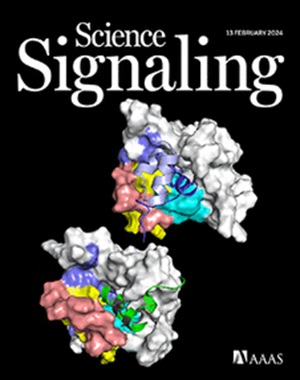脑毛细血管腔压升高驱动trpc3依赖性去极化和移行周细胞收缩
IF 6.6
1区 生物学
Q1 BIOCHEMISTRY & MOLECULAR BIOLOGY
引用次数: 0
摘要
大脑的自动调节保证了血液的持续流动,这是大脑健康的基本条件。脑循环的一个基本参数是微血管直径的动态调节,以适应血压变化的阻力。周细胞是包裹在毛细血管内皮周围的一类壁细胞,参与毛细血管直径的动态控制。我们试图通过体内双光子显微镜、电生理学和体外小动脉-毛细血管肌图来确定脑周细胞是否以及如何收缩以响应血压升高,这些小鼠有条件的壁细胞敲除或基因编码的Ca2+指示剂的表达。在一至四阶毛细血管中,周细胞通过降低管腔直径、去极化膜电位和增加细胞质Ca2+信号传导,对压力表现出快速而可测量的反应。药理学和影像学方法显示瞬时受体电位通道3 (TRPC3)和电压门控Ca2+通道依次激活,促进快速收缩。TRPC3基因消融导致电流减少,膜去极化丧失,在过渡周细胞中,在标准压力曲线上产生的张力几乎完全消融,但在上游小动脉中没有。总之,我们的研究结果确定TRPC3通道激活对于近端周细胞去极化和收缩响应压力至关重要,突出了小动脉和毛细血管血流调节之间的信号差异。本文章由计算机程序翻译,如有差异,请以英文原文为准。

Increased luminal pressure in brain capillaries drives TRPC3-dependent depolarization and constriction of transitional pericytes
Cerebral autoregulation ensures constant blood flow, an essential condition of brain health. A fundamental parameter of the brain circulation is the dynamic regulation of microvessel diameter to allow for adjustments in resistance to blood pressure changes. Pericytes are a family of mural cells that wrap around the capillary endothelium and contribute to the dynamic control of capillary diameter. We sought to determine whether and how brain pericytes constrict in response to blood pressure elevation with in vivo two-photon microscopy, electrophysiology, and ex vivo arteriolar-capillary myography of mice with conditional mural cell knockout or with expression of a genetically encoded Ca2+ indicator. In first- to fourth-order capillaries, pericytes displayed a rapid and measurable response to pressure by decreasing luminal diameter, depolarizing membrane potentials, and increasing cytoplasmic Ca2+ signaling. Pharmacological and imaging approaches revealed that transient receptor potential channel 3 (TRPC3) and voltage-gated Ca2+ channels were sequentially activated to promote fast constriction. Genetic ablation of TRPC3 resulted in decreased currents, loss of membrane depolarization, and near-complete ablation of the generation of tone over a standard pressure curve in transitional pericytes but not in upstream arterioles. Together, our findings identify TRPC3 channel activation as critical for proximal pericyte depolarization and contraction in response to pressure, highlighting the signaling differences between arteriolar and capillary blood flow regulation.
求助全文
通过发布文献求助,成功后即可免费获取论文全文。
去求助
来源期刊

Science Signaling
BIOCHEMISTRY & MOLECULAR BIOLOGY-CELL BIOLOGY
CiteScore
9.50
自引率
0.00%
发文量
148
审稿时长
3-8 weeks
期刊介绍:
"Science Signaling" is a reputable, peer-reviewed journal dedicated to the exploration of cell communication mechanisms, offering a comprehensive view of the intricate processes that govern cellular regulation. This journal, published weekly online by the American Association for the Advancement of Science (AAAS), is a go-to resource for the latest research in cell signaling and its various facets.
The journal's scope encompasses a broad range of topics, including the study of signaling networks, synthetic biology, systems biology, and the application of these findings in drug discovery. It also delves into the computational and modeling aspects of regulatory pathways, providing insights into how cells communicate and respond to their environment.
In addition to publishing full-length articles that report on groundbreaking research, "Science Signaling" also features reviews that synthesize current knowledge in the field, focus articles that highlight specific areas of interest, and editor-written highlights that draw attention to particularly significant studies. This mix of content ensures that the journal serves as a valuable resource for both researchers and professionals looking to stay abreast of the latest advancements in cell communication science.
 求助内容:
求助内容: 应助结果提醒方式:
应助结果提醒方式:


